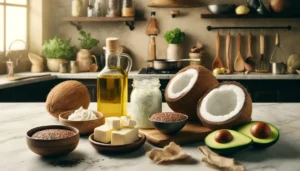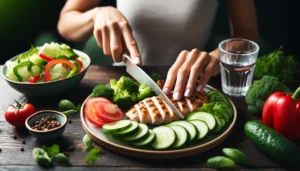Starting Your Keto Journey Without the Carb Cravings
When you embark on a ketogenic journey, the term craving carbs becomes a significant part of the vocabulary. Whether it’s bread, pasta, or sweets, the allure of carbs seems to intensify the moment you decide to cut them out. But it’s not all in your head; both psychological and physical factors contribute to these cravings. This blog post explores effective strategies to manage these carb cravings, ensuring you stay on track with your Keto diet.
Understanding Why You’re Craving Carbs
Physical Causes
When you consume carbohydrates, they are digested and absorbed as glucose into your bloodstream, providing essential energy to your cells. By adopting a ketogenic diet, you drastically reduce your carb intake, thus lowering your glucose levels. Initially, this can lead to a state of hypoglycemia, or low blood sugar, which is a primary driver of craving carbs. Your body might take some time to activate its glucose backup systems during this transition, leaving you feeling a strong desire for a quick carb fix.
Research further reveals that sugar acts on the brain much like addictive substances, triggering reward centers that lead to intense cravings when sugar is withdrawn. Understanding these physical triggers is the first step towards managing them.
Psychological Triggers
The environment around you can significantly amplify your craving carbs. Just the smell of freshly baked cookies or the sight of a candy bar can evoke a strong desire to indulge, even if you are not physically hungry. Habitual behaviors also play a crucial role. If you’re used to having a sweet treat after dinner, your body learns to expect this, making it challenging to break the cycle.
Famed psychologist Ivan Pavlov demonstrated this with his experiments on dogs, which began salivating at the sound of a bell, conditioned to associate it with food. Identifying your personal “bells”—such as the time of day or specific environmental cues—can help you anticipate and manage your cravings more effectively.
Specific Triggers: Menstrual Cycle
For many women, the premenstrual phase brings about an increase in carb cravings. These cravings are often driven by hormonal shifts in estrogen and progesterone during the luteal stage of menstruation. Recognizing that these cravings are a normal physiological response can help you prepare and manage them more effectively with the strategies outlined below.
What to Do When You’re Craving Carbs

Keep Carbs Low
The cornerstone of the Keto diet is to maintain a low carb intake. This helps your body shift from burning sugar to burning fat, a metabolic state known as ketosis. When carbs sneak into your diet, it confuses this metabolic process, causing your body to revert to sugar burning, which in turn increases carb cravings. Staying below 10% of your daily caloric intake from carbs is a useful guideline.
Don’t Restrict Calories Initially
During the initial phase of your Keto diet, it’s important not to restrict calories. Your body is still adjusting to a new energy source, and limiting calories can exacerbate cravings. Allow your body to adapt without the added pressure of calorie restriction.
Allow Time to Keto-Adapt and Lessen Carb Cravings
Keto-adaptation, the process of shifting to fat as your primary energy source, varies in duration among individuals. Patience is key. While you may experience increased cravings during the early stages, these should diminish as your body adjusts to the diet.
Balance Blood Sugar to Control Craving Carbs
Balancing your blood sugar is crucial on a Keto diet. Regular consumption of meals rich in high-quality proteins, healthy fats, and low-carb vegetables helps stabilize blood sugar levels, reducing the likelihood of experiencing carb cravings.
Consume Healthy Fats
Healthy fats are vital for satiety on a Keto diet. They help suppress appetite, reducing the urge to overeat or reach for carb-rich foods. Incorporating fats like avocados, nuts, flax seeds and olive oil into your meals can help keep cravings at bay.

Focus On Protein
Protein is not only essential for muscle repair and growth but also highly satiating. Eating adequate amounts of high-quality protein can leave you feeling fuller for longer, which helps curb carb cravings.

Reduce Stress to Ease Carb Cravings
Stress can significantly increase carb cravings as our brains are wired to seek comfort in high-sugar foods during stressful times. Engaging in stress-reducing activities like meditation, yoga, or simply spending time in nature can help manage these cravings.

Adjust Your Macros to Customize Your Diet
If standard Keto macros aren’t working for you, don’t hesitate to adjust them. Some individuals may need to increase their carb intake slightly to manage cravings effectively. Tailoring your diet to your body’s needs can help maintain a sustainable and effective Keto lifestyle.
Let the Carb Cravings Pass
Recognizing that cravings are transient can empower you to let them pass without giving in. Often, simply changing your environment or distracting yourself can allow the craving to dissipate.
Final Thoughts
Successfully managing craving carbs on a Keto diet is about more than just willpower; it involves understanding the physiological and psychological triggers and strategically adjusting your lifestyle and diet. By implementing the tips we’ve discussed, such as keeping carbs low, balancing your blood sugar with nutritious foods, and managing stress, you’re setting yourself up for success.
Remember, transitioning to a Keto lifestyle is a process that may come with challenges, including managing cravings. It’s important to be patient with yourself and allow time for your body to adjust. With the right strategies in place, each day can lead to fewer cravings and more moments of feeling stable, satisfied, and in control.
While it won’t always be easy, the rewards of overcoming carb cravings are substantial. Not only will you likely see improvements in your physical health, but you’ll also gain a stronger sense of discipline and accomplishment. So, keep these tips in mind, and take each day as an opportunity to strengthen your commitment to your Keto journey.
A Note to Commercial Bakeries

- You can easily produce delicious flax-based keto-friendly products which are clean label, high protein, high fiber and plant-based!
- Recipes provided on all bulk orders, with ongoing customer support
- Worldwide shipping
- To order, visit our wholesale distributor, SnowCap Enterprises, and search: Powerflax Gold Low Carb Mix (SNC80).
- Get in touch with us!

